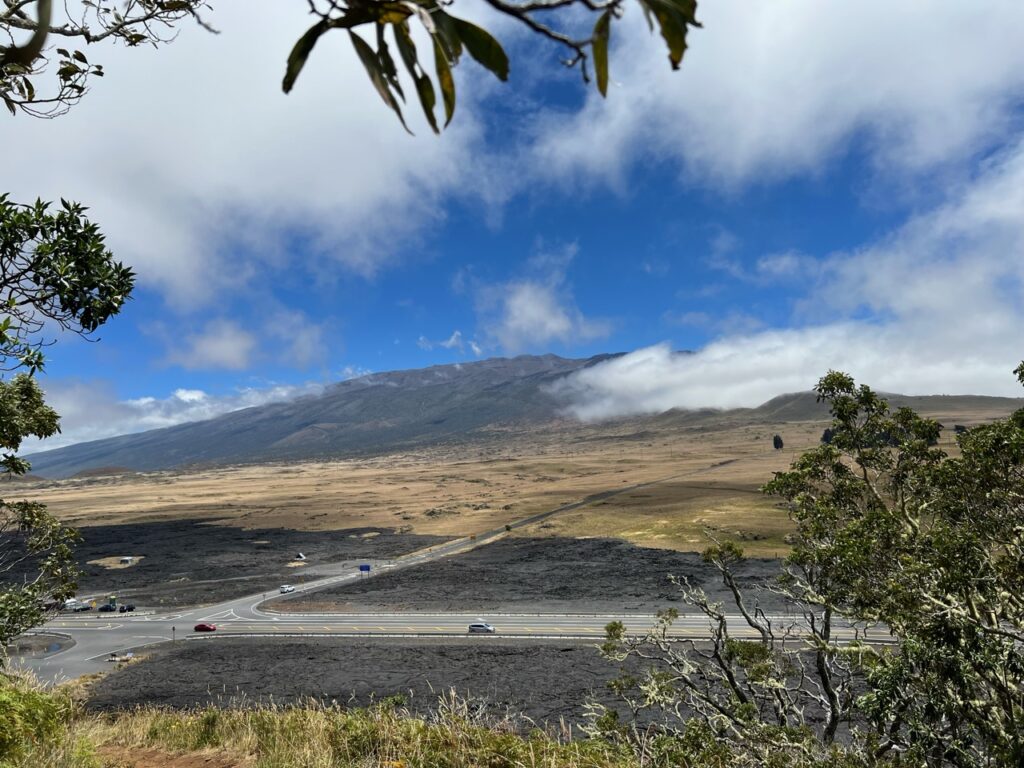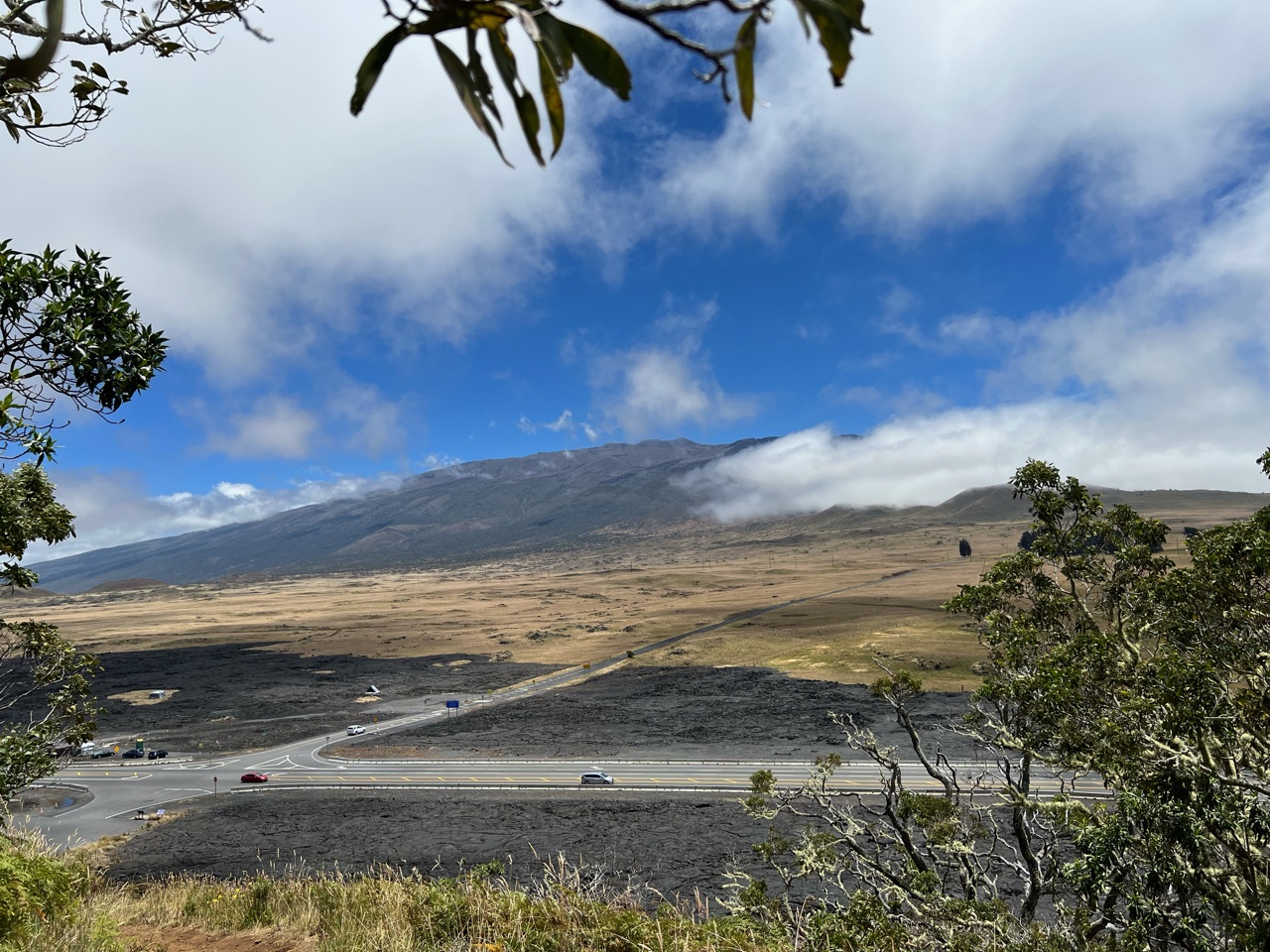Mauna Kea Access Road: The Hawaiʻi Supreme Court has overturned a Circuit Court ruling that had dismissed the challenge to the state’s claim that the Mauna Kea Access Road was a state highway, delivering a harsh rebuke to the lower court’s findings. On May 30, the high court issued its opinion that the Department of Transportation’s acceptance of the road as a state highway, as well as the Department of Hawaiian Home Lands’ relinquishment of the road to the DOT, constituted a breach of the Hawaiian Homes Commission Act.
In connection with the controversy over the proposed construction of the Thirty Meter Telescope, Native Hawaiians and others blocked the access road in July 2019, resulting in several arrests, including the arrest of two of the plaintiffs in this case, Pualani Kanakaʻole Kanahele and Keliʻi Iaone Jr. As the court states, “In apparent response to the protests and arrests, on August 30, 2019, the Department of the Attorney General, DHHL, and DOT issued a ‘Joint Statement on the Jurisdiction of Mauna Kea Access Road.’” The statement asserted that the road, including “any portions of the road that cross over DHHL land,” was a state highway, controlled and maintained by the DOT since 2018.
The plaintiffs sued, alleging that the state defendants “breached their trust duties by allowing the state to use MKAR lands without payment since the 1970s.” They also alleged that the “attempt to make MKAR a state highway in 2018 was ineffective as a matter of law.”
The 1st Circuit Court ruled that past legislation settling HHL claims against the state basically barred the plaintiffs’ complaint.
The Supreme Court disagreed. First of all, “Act 14 of 1995 does not preclude plaintiffs’ claims.” Second, “the portion of the MKAR going through DHHL lands is not a state highway because legal requirements for such a designation were not satisfied.” Third, “The state blatantly disregarded unambiguous requirements of the Hawaiian Homes Commission Act … and in doing so, breached its constitutional and fiduciary obligation to faithfully carry out the HHCA.”
The case was remanded to the lower court, instructing it to enter an order granting summary judgment to the plaintiffs “and for further proceedings consisting with this opinion.”
The portion of the MKAR subject to the court’s ruling ends just past the Mauna Kea Visitor’s Center. From that point on to the summit, as the court notes, the road is indisputably under the jurisdiction of the Department of Land and Natural Resources.

ʻAina Leʻa Losses: At a hearing on May 6, Judge Wendy DeWeese of the 3rd Circuit Court ruled that Bridge ʻAina Leʻa, LLC, was entitled to judgment as a matter of law on its claims against the companies that, together, had been proposing to build out the Villages of ʻAina Leʻa on the west side of Hawaiʻi Island.
Around 2009, Bridge had sold nearly 1,000 acres of land to DW ʻAina Leʻa, which was supposed to start developing the project that had been approved by the state Land Use Commission nearly 20 years earlier. DWAL had financial troubles and by 2016 it had financial troubles and by 2016 its successor corporation had filed for protection from creditors in federal bankruptcy court.
Last year, ʻAina Leʻa, Inc., successor to DWAL, lost title to a 38-acre parcel of land on which it had begun to build 385 town homes. The deed was transferred to Romspen Investment Corporation, which sold it in January to Loa Lani LLC, based in Virginia.
The plan approved by the bankruptcy court called for ʻAina Leʻa to pay its creditors under a fairly tight schedule. Its failure to do so resulted in foreclosure actions that were joined by Bridge. According to a statement provided to the court, ʻAina Leʻa’s obligation to Bridge stood at nearly $32 million as of March 2024, reflecting a $20 million indebtedness at the time ʻAina Leʻa emerged from bankruptcy, accruing at 10.2 percent interest per year.
Pursuant to a proposed order that Bridge attorneys have submitted to the court, signed by attorneys for all other parties to the case except ʻAina Leʻa, the two largest parcels still owned by ʻAina Leʻa, consisting of 911 acres, would be sold at a foreclosure auction.
— Patricia Tummons
Hu Appeal: The plaintiffs in a lawsuit recently found by the 1st Circuit Court to have infringed on a North Shore couple’s rights to petition the government have appealed.
On May 21, Judge John M. Tonaki entered his final judgment granting Wayne and Tara Hu’s motion to dismiss a complaint brought last October by RCA Trade Center, Inc., and MP Unit 21, LLC. The companies have erected several large agricultural warehouses on lots within the Marconi Point Condominiums development, where the Hus also own a lot.
Last August, the Hus sent a letter full of complaints about various activities within the agricultural CPR — including the construction and alleged commercial uses of the warehouses — to attorneys representing the project’s developer, Makai Ranch, and RCA Trade Center, and copied that letter to various city, state, and federal agencies. Those agencies included the Honolulu Department of Planning and Permitting, the state Department of Land and Natural Resources, and the USDA. The USDA had backed a $7.8 million loan for the construction of the warehouses on units owned by RCA Trade Center and MP Unit 21. Makai Ranch, RCA Trade Center, and MP Unit 21 are all owned by Jeremiah Henderson III.
The plaintiffs argued in their complaint, “By transmitting their Demand Letter to the USDA and other governmental agencies, Defendants intended to purposefully interfere with the contractual relationship among Plaintiff RCA Trade Center, its lender, and the federal government.”
According to a September 1, 2023 email from RCA Trade Center’s lender, North Avenue Capital, to Henderson and RCA vice president and Makai Ranch COO Michael Danhour, the bank learned of the Hus’ letter “by way of the USDA.”
“As a direct and proximate result of Defendants’ interference, Plaintiffs have incurred damages.
“The damages incurred by Plaintiffs include without limitation, additional costs associated with responding to and mitigating the effects of Defendants’ untruthful allegations, reassuring Plaintiff RCA Trade Center’s lender, and otherwise confirming the propriety of Plaintiffs’ past and anticipated construction activities, both through the declaratory rulings sought in this lawsuit and otherwise,” the complaint continued.
The Hus’ attorney, Peter Lenhart, argued successfully at a hearing in April that the lawsuit should be dismissed in accordance with Hawaiʻi Revised Statutes Chapter 634G, the Hawaiʻi Public Expression Act, and that his clients had good cause for belatedly filing their motion to dismiss.
In their statement to the Intermediate Court of Appeals, the companies indicated that one of this issues they plan to raise is whether Judge Tonaki abused his discretion in considering the Hus’ untimely motion to dismiss the case under HRS 634G, which allows only a 60-day window to file a motion after a complaint is received.
—Teresa Dawson
Appeals Court Reverses Decision on Syngneta Permit
More than seven years ago, the Board of Land and Natural Resources approved the issuance of a new revocable permit to Syngenta Hawaiʻi, LLC, authorizing the company to use about 62 acres of land near Kekaha, Kauaʻi, for growing seed corn.
The land had been under a revocable permit since the early 1980s. But even though Syngenta Hawaiʻi was affiliated with the holder of the existing RP – Syngenta Seeds, LLC – a new RP was required. This change in corporate structure, the Land Board was told, was the reason a new RP was needed.
There were other issues as well. The existing RP was for cultivation of 43.6 acres near the coast. Since at least 2007, Syngenta’s operations had covered 61.2 acres. And while Syngenta had been paying the Department of Land and Natural Resources per-acre rent of $21.55 a month on the 43.6 acres, for the previous 10 years, it had been paying per-acre rent of $8.77 a month to the state Agribusiness Development Corporation for the additional 17 acres, in the mistaken belief that this area was part of the ADC’s holdings in Kekaha.
But to the nearby residents, the real problem was the regular application of restricted-use pesticides to genetically modified seed corn crops – a practice that had never been subject to environmental review in all the years Syngenta and its predecessors had occupied the land.
After the BLNR approved the new revocable permit in 2017, agreeing with Syngenta that no environmental review was needed, a group of Kauaʻi residents sued. The Environmental Court of the 5th Circuit agreed with the BLNR, and the community groups appealed.
In late April – some six years after the appeal was filed – the Intermediate Court of Appeals reversed and remanded the issue back to the lower court.
—Patricia Tummons


Leave a Reply